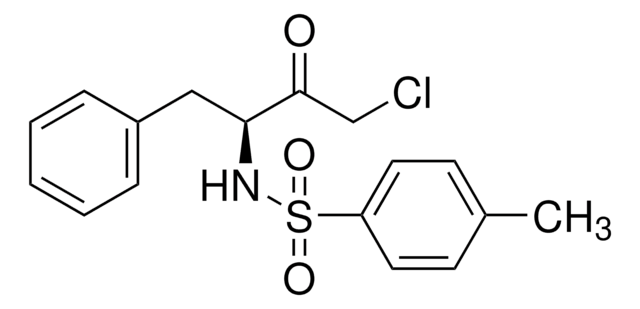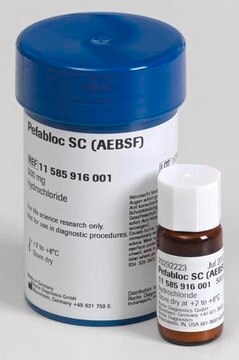52332
Phenylmethylsulfonyl Fluoride
Phenylmethylsulfonyl Fluoride, CAS 329-98-6, is an irreversible inhibitor of serine proteases. It causes sulfonylation of the active-site serine residues.
Sinónimos:
Phenylmethylsulfonyl Fluoride, Benzylsulfonyl Fluoride, PMSF
About This Item
Productos recomendados
Quality Level
assay
≥99% (GC)
form
crystalline solid
manufacturer/tradename
Calbiochem®
storage condition
OK to freeze
desiccated
color
white to off-white
solubility
ethanol: soluble
isopropanol: soluble
methanol: soluble
shipped in
ambient
storage temp.
10-30°C
InChI
1S/C7H7FO2S/c8-11(9,10)6-7-4-2-1-3-5-7/h1-5H,6H2
InChI key
YBYRMVIVWMBXKQ-UHFFFAOYSA-N
General description
Biochem/physiol Actions
serine proteases
Warning
Reconstitution
Other Notes
Weaver, V.M., et al. 1993. Biochem. Cell. Biol.71, 488.
Bourgain, R.H., et al. 1992. Adv. Exp. Med. Biol.316, 427.
Chang, C.T., et al. 1992. Biochem. Int.28, 707.
Legal Information
signalword
Danger
hcodes
Hazard Classifications
Acute Tox. 3 Oral - Skin Corr. 1B
Storage Class
6.1A - Combustible acute toxic Cat. 1 and 2 / very toxic hazardous materials
wgk_germany
WGK 3
flash_point_f
Not applicable
flash_point_c
Not applicable
Certificados de análisis (COA)
Busque Certificados de análisis (COA) introduciendo el número de lote del producto. Los números de lote se encuentran en la etiqueta del producto después de las palabras «Lot» o «Batch»
¿Ya tiene este producto?
Encuentre la documentación para los productos que ha comprado recientemente en la Biblioteca de documentos.
Los clientes también vieron
Nuestro equipo de científicos tiene experiencia en todas las áreas de investigación: Ciencias de la vida, Ciencia de los materiales, Síntesis química, Cromatografía, Analítica y muchas otras.
Póngase en contacto con el Servicio técnico












